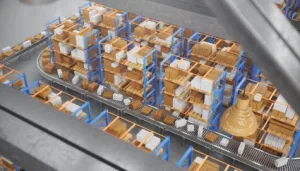Choosing the Right Racking System for Logistics Optimization

In today’s fast-paced supply chain environment, efficient warehouse solutions and logistics optimization are crucial for maintaining productivity and reducing operational costs. Whether you’re managing a small warehouse or a large industrial distribution center, the key to success often lies in how well you use your space. Smart storage solutions—especially the right industrial shelving and racking systems—play a pivotal role in this equation. This article explores the essential components of optimized warehouse storage, with a focus on used pallet racking, industrial racks, and modern shelving strategies tailored for efficiency and growth.
The Foundation of Efficient Warehousing
Understanding the of Storage Design
Before diving into types of shelving or racking systems, it’s important to understand the core goal of any warehouse storage strategy: maximize storage space while ensuring accessibility and safety. Poorly designed warehouse racking solutions can lead to bottlenecks in operations, product damage, inefficient inventory tracking, and even workplace accidents.
Smart warehouse design starts with a deep understanding of your inventory, workflows, product dimensions, and throughput requirements.
Why Logistics Optimization Begins with Smart Racking
Efficient logistics doesn’t just mean fast delivery—it begins inside your warehouse. The layout and type of racking systems directly influence the speed at which inventory is picked, packed, and shipped. For example:
- Selective racking enables easy access to individual pallets, ideal for high SKU variety.
- Drive-in/Drive-thru racking maximizes space but is suited for low-turnover products.
- Push-back or pallet flow racking improves inventory rotation for FIFO/LIFO needs.
Choosing the right system helps reduce time spent retrieving products and increases overall throughput.
Used Pallet Racking: A Budget-Friendly Optimization Strategy
Used pallet racking is becoming increasingly popular among businesses looking to optimize their warehouse without incurring hefty capital expenses. These systems offer:
- Lower upfront investment: Ideal for startups or growing businesses.
- Quick installation: Pre-assembled or easily assembled parts save time.
- Sustainability: Reusing materials supports green warehouse initiatives.
While buying used, ensure the racking is structurally sound and adheres to safety standards. Partnering with reputable vendors is critical to avoid compromised material integrity.
Key Benefits of Industrial Racks in Modern Logistics
- Maximized Vertical Space
Industrial racking allows warehouses to grow vertically rather than horizontally, utilizing airspace to its full potential. This reduces the need for facility expansion and cuts down on real estate costs.
- Improved Inventory Management
With better organization, products are easier to locate and track, reducing errors and saving time. Industrial shelving systems often integrate with warehouse management systems (WMS) for real-time visibility.
- Enhanced Safety
High-quality racking systems are engineered for stability, reducing the risk of collapses or falling objects. Many modern racks come with safety accessories like pallet stoppers, guards, and load signage.
- Customizability
From adjustable shelves to modular components, industrial racks can be tailored to your specific load size, weight capacity, and product type.
Types of Warehouse Racking Systems
Selective Pallet Racking
The most commonly used racking system, providing direct access to every pallet. Best for operations with a high number of SKUs and varying product demand.
Drive-In/Drive-Thru Racking
High-density storage ideal for bulk goods with low product rotation. Forklifts enter the racking system to load or retrieve pallets.
Cantilever Racking
Perfect for storing long or awkwardly shaped items like pipes, steel bars, or lumber. It offers open front access with no vertical obstructions.
Push-Back Racking
Allows multiple pallets to be stored on inclined rails. When a pallet is removed, the next one slides forward. This system maximizes storage depth while maintaining selectivity.
Pallet Flow Racking
Uses gravity rollers to move pallets from the loading side to the picking side. Suitable for FIFO (First In, First Out) inventory rotation.
Choosing the Right Racking System
When selecting a racking system, consider the following criteria:
- Product type and size
- Weight capacity per shelf
- Inventory turnover rate
- Available floor and vertical space
- Forklift accessibility
- Safety and compliance regulations
Working with a warehouse consultant or storage specialist can help tailor solutions to your specific operational goals.
Integrating Technology for Maximum Efficiency
Modern logistics optimization doesn’t stop at hardware. Many warehouses now integrate racking systems with smart technologies such as:
- Automated Storage and Retrieval Systems (AS/RS)
- RFID tagging and scanning
- IoT sensors for load monitoring
- Cloud-based WMS
These systems reduce human error, optimize stock levels, and improve decision-making with real-time data analytics.
Maintenance and Safety Best Practices
Warehouse shelving and racking are long-term investments, and like any equipment, they require ongoing care.
Maintenance Tips:
- Regularly inspect for rust, loose bolts, or damaged beams
- Train employees on proper loading procedures
- Ensure all loads comply with capacity ratings
- Use safety pins and lock-in mechanisms to prevent dislodgment
- Schedule professional inspections annually
Staying proactive with maintenance prevents costly accidents and extends the lifespan of your storage infrastructure.
Final Thoughts:
Whether you’re expanding your operations or simply trying to make better use of your existing space, warehouse racking systems are not just storage—they are strategic tools for logistics optimization. From used pallet racking to sophisticated flow racks, choosing the right industrial shelving can dramatically improve your warehouse’s efficiency, safety, and scalability.
